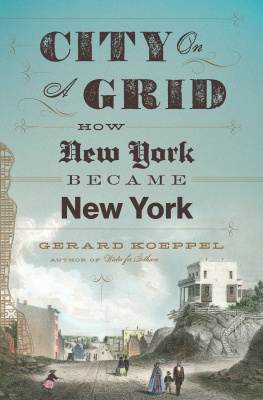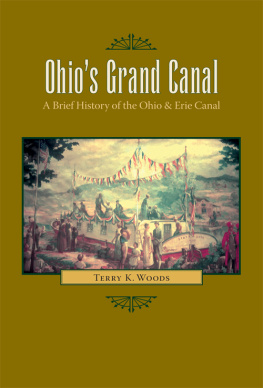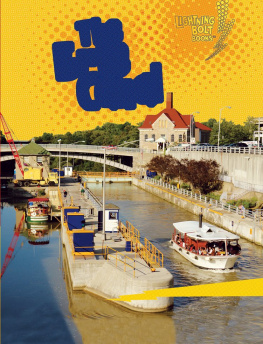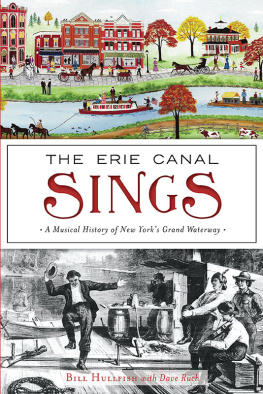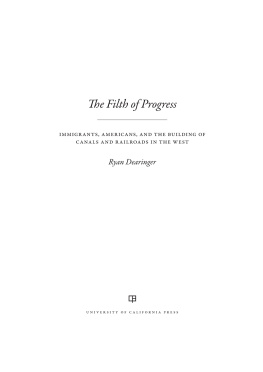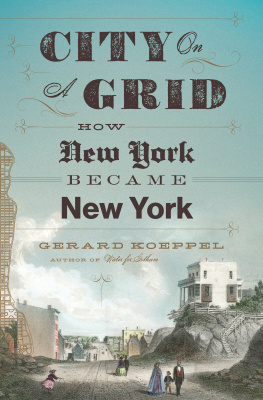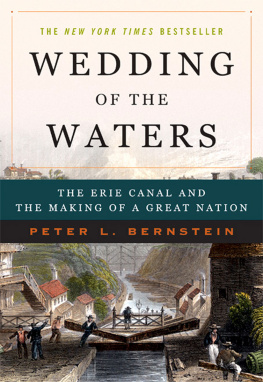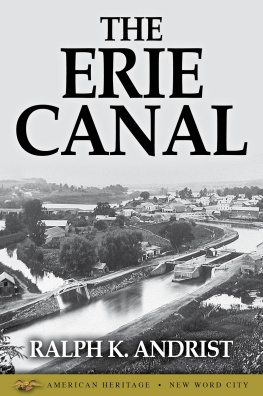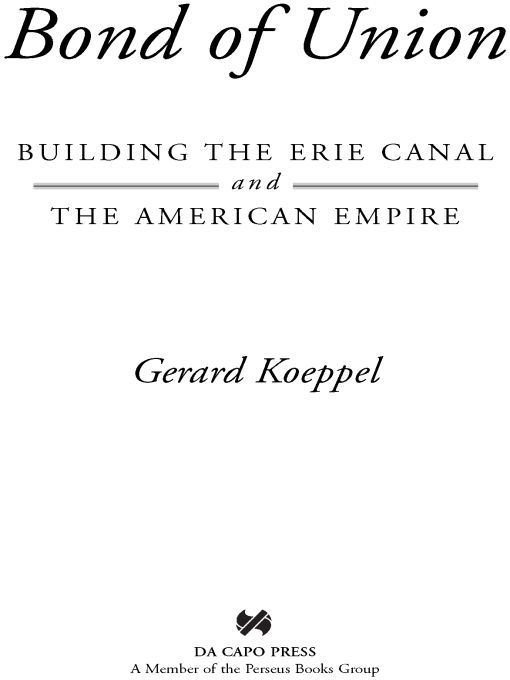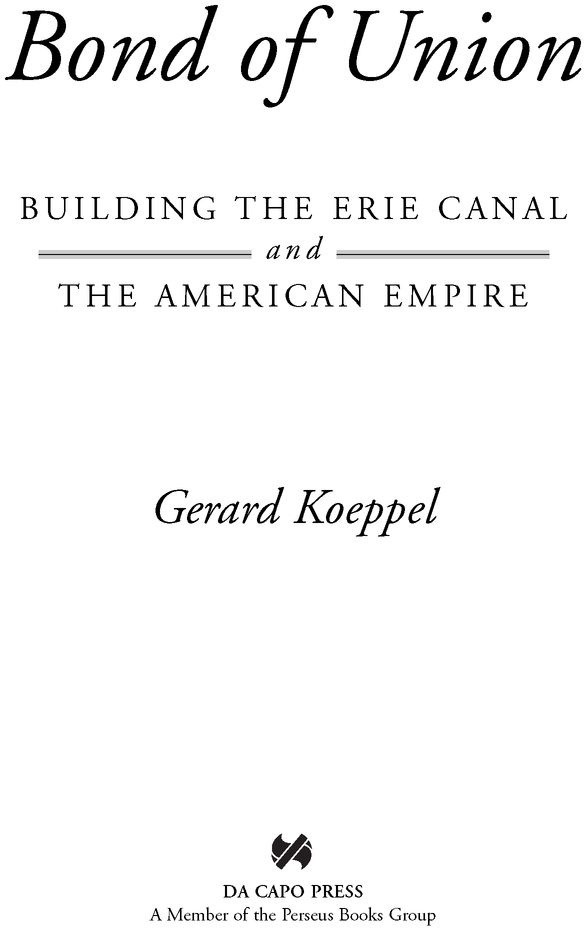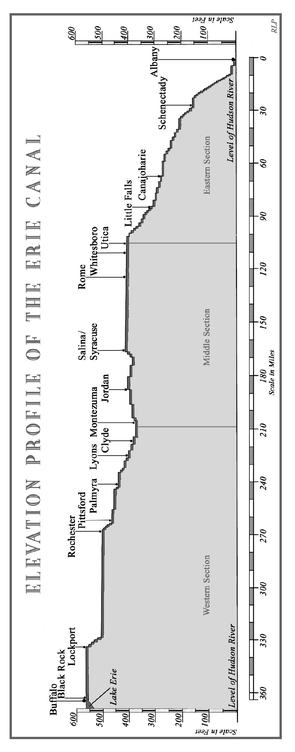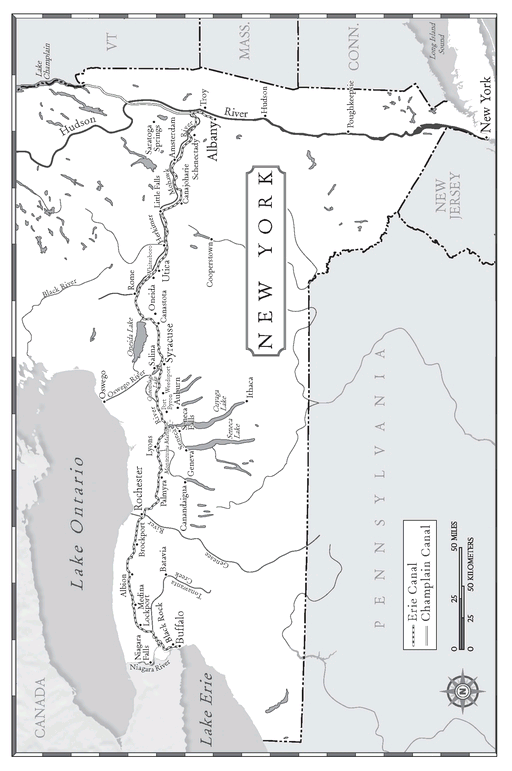Table of Contents
For Diane, Jackson, Harry, Kate, and Scrappy
Pleasure is a shadow, wealth is vanity, and power a pageant; but knowledge is ecstatic in enjoyment, perennial in fame, unlimited in space, and infinite in duration.
DE WITT CLINTON,
address to Phi Beta Kappa Society, Union College,
Schenectady, New York, July 22, 1823
CHAPTER 1
An American Ambition
The building of the Erie Canal was an act of faith, the demonstration
of a spirit of enterprise by an organized government that has few
parallels in world history.
George Rogers Taylor,
The Transportation Revolution (1951)
The morning came on cool and bright. A recent frost had just begun to color the surrounding forest autumn. The blue sky and chill air mingled the past with the future, experience with expectation. In the frontier village of Buffalo, possibly even in the whole of New York State, there was no more expectant time than Wednesday, October 26, 1825. The population of just over twenty-four hundred had been swelled by dozens of the states political and merchant leaders and hundreds of settler families from the surrounding countryside, all eager to celebrate the completion of the great project that would determine their fortunes and those of many others.
Gathered in the Lake Erie port that twenty years earlier had been just a mark on a land developers map, the leaders of New York betrayed no uncertainties. Their state had just surged past Virginia and Pennsylvania to become the most populous of the United States. New Yorks namesake city had recently displaced Philadelphia as the nations largest and was taking control of the young American economy. In fields, drawing rooms, and countinghouses across the Atlantic, the words New York were becoming equivalent to economic opportunity for laborers, speculators, and protoindustrialists alike. And yet, until this fall morning, New York was no more assured of becoming The Empire State than was Virginia, Pennsylvania, or even Ohio, South Carolina, or Illinois. Nor was the nation assured of becoming the global empire it remains.
In 1825 the United States were still plural and few: not a singular nation-state but sovereign states with a constitutionally limited federal government. As late as 1855, Walt Whitman proclaimed with verbal plurality, the United States with veins full of poetical stuff most need poets. Abraham Lincoln, declaring the Union at Gettysburg, finally changed the grammar and perception in the 1860s. In 1825 the sea-to-shining-sea continental nation of patriotic song was still a dream: the land was vast, access to and control of it was limited. The Louisiana Territory had been purchased two decades earlier but remained mostly unorganized. Mexicos north stretched from the Sabine River on the Gulf of Mexico to the 42nd parallel on the Pacific Ocean, encompassing all of what are now Texas, New Mexico, Arizona, Utah, Nevada, and California (as well as parts of Colorado, Oklahoma, Wyoming, and Kansas). The Pacific Northwest was open country. The Appalachian mountain range, guarding the interior from South Carolina to what only recently had become Maine, threatened to confine the great American experiment to the Atlantic seaboard. The allegiance of the several new transmontane states was unproven; their settlers looked west down rolling river valleys toward the mighty Mississippi, not over their shoulders at the mountains that separated them from their political creators. Former vice president Aaron Burrs enigmatic conspiracy of 1805-1806to make a nation for himself and others in the region opened by the Louisiana Purchasehad come apart but illustrated the limited control exerted by the east over the west, of the national government over its unsettled territory. A continental nation was so uncertain that President Thomas Jefferson had deemed it optional: Whether we remain in one confederacy, or form into Atlantic and Mississippi confederacies, I believe not very important to the happiness of either part. The coming of the steamboat in 1807 gave hope for connectedness but illustrated the lack of it: soon there were boats on the Hudson and the Mississippi rivers but no true navigation between them.
The War of 1812 proved over its desultory three-year course that the United States remained a shaky nation. The British burned Washington. President James Madison escaped on horseback, separated from his Dolley. The British also burned Buffalo and neighboring Black Rock. The pioneers of Western New York fled east in terror. There was no defending the states western flank by the effective transportation of arms and supplies. The few roads were so abominable that the federal government spent a staggering $60 million on wartime transport, including a dollar a pound for cannonballs that cost a fraction of that to produce. The cost of moving artillery from Albany to the major naval warfront on Lake Erie was more than double its purchase price; transportation of material from Washington to the lake was up to five times the production cost. The British blockade of American ports forced coastal shipping onto primitive land routes: one wagon of war supplies loaded in Worcester, Massachusetts arrived in Charleston, South Carolina, two and a half months later. Nothing had changed dramatically in the decade since peace was restored. Until the Erie Canal opened on a fine fall day in 1825.
The canal was a slender thing: 363 miles across the breadth of New York from Albany to Buffalo, but only forty feet wide and four feet deep. A ribbon of water, the canal traversed by turns malarial swamp, dense forest, rock ridge, steep valley, and arid plateau. For its eastern 125 miles the canal claimed from the Mohawk River a strip of its storied valley, where industry was gaining a foothold amid the rich lore of native, patriot, and settler life. The western two-thirds of the canal passed through sparsely settled territory, a sliver of progress that would convert frontier regions into centers of worldwide commerce. Conceived in the earliest 1800s, the canal was the boldest and biggest American engineering project of its century, with enduring political, social, and economic effect. Two centuries later, the canal remains probably the outstanding example of a human artifact creating wealth rapidly in the whole of history.
A child clawing a channel through sand at waters edge or flicking a stick to link sidewalk puddles indulges the human instinct to create waterways. Canals are as old as the ingenuity of humans trying to move themselves or their things more quickly and cheaply. Some ancient and medieval canals were of considerable length, but all connected points at the same elevation. How to raise and lower the level of an artificial waterway was unknown. Modern canal engineering was born in the 1480s when Leonardo Da Vinci, famously improving on earlier Dutch designs, designed locks to join existing level canals in Milan. A canal lock is a chamber with gates at each end placed at an elevation change; the sequential opening and closing of the gates raises or lowers a boat that has entered the lock chamber. Although locks were simple in concept, the challenges for early designers were to make them durable, watertight, and practicable, and to find ample water to replace the lock-fulls released to the lower elevation. The earliest lock gates moved vertically, subjecting them to great pressure and friction. Leonardos innovation was paired mitered lock gates forming a V pointed in the direction of the higher water. Water was deflected to the sides when the gates were swung open, and pressure sealed the lock when the gates were closed. Over half a millennium later, canal locks are still built the same way.


